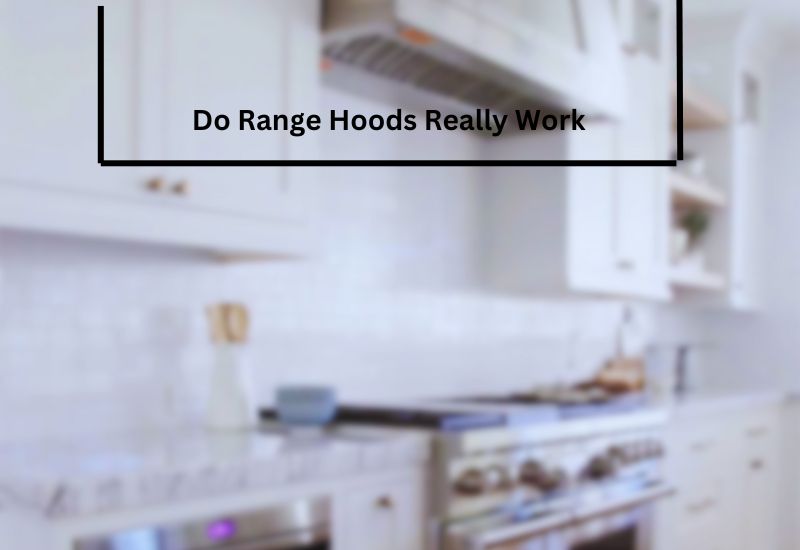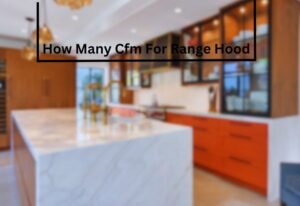Introduction:
Have you ever wondered about the purpose of that large appliance hanging above your kitchen stove? That’s a range hood, and it’s not just a decorative element – it serves a vital role in keeping your kitchen environment clean and safe. Range hoods are designed to remove smoke, odors, grease, and airborne particles that are generated while cooking. This not only helps maintain a fresh-smelling kitchen but also improves indoor air quality.
Do Range Hoods Really Work? Yes, range hoods are effective kitchen appliances. They work by capturing and venting out smoke, grease, and odors produced during cooking. A properly functioning range hood improves indoor air quality, prevents the buildup of harmful particles, and reduces the risk of fire hazards in the kitchen.
In this exploration of the functionality of range hoods, we’ll delve into how they work, their benefits, and whether they’re truly effective in maintaining a healthier cooking space. We’ll also address common misconceptions and provide insights into choosing the right type of range hood for your kitchen setup. So, if you’ve ever pondered whether range hoods are more than just eye-catching additions to your culinary space, join us as we uncover the science and practicality behind these often-underappreciated kitchen appliances.
Understanding the Functionality of Range Hoods
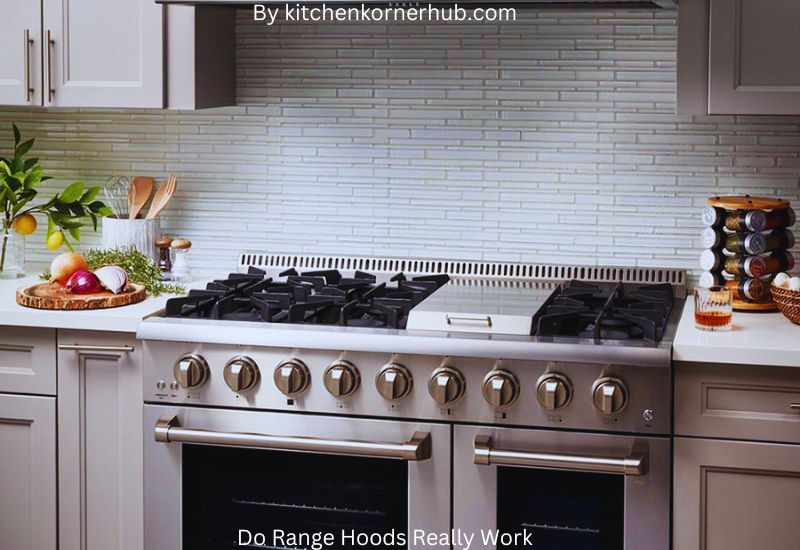
Range hoods, an indispensable feature in modern kitchens, play a crucial role in maintaining a clean and safe cooking environment.
These appliances are designed to effectively manage the airborne pollutants, odors, and excess heat that cooking generates. Their functionality encompasses various aspects, making them an essential addition to any culinary workspace.
Airborne Pollutant Extraction:
Range hoods excel at extracting airborne pollutants, such as smoke, grease, and steam, which are natural byproducts of cooking. The primary mechanism behind this function is the powerful fan built into the hood.
As it operates, the fan pulls in the polluted air, trapping particles like grease and smoke in filters or screens. This prevents these particles from spreading throughout the kitchen and even the entire house.
Odor Elimination:
Cooking can sometimes produce strong and lingering odors that can be unpleasant and affect the ambiance of the home. Range hoods combat this issue by capturing and venting out the odorous air through ducts that lead to the outside.
Additionally, many advanced range hoods come equipped with charcoal filters that effectively absorb and neutralize odors before recirculating the air back into the kitchen.
Heat Dissipation:
Another important function of range hoods is heat dissipation. Cooking appliances generate a significant amount of heat, which can lead to discomfort and even contribute to the overall temperature of the home.
Range hoods help mitigate this by drawing away the hot air produced during cooking, aiding in maintaining a cooler and more comfortable environment in the kitchen.
Smoke and Grease Prevention:
Cooking methods that involve high temperatures, like grilling or frying, can produce smoke and grease that not only contaminate the air but also create an increased risk of kitchen fires.
Range hoods offer protection against these hazards by efficiently capturing and removing the smoke and grease particles before they can settle on surfaces, minimizing the risk of fire and simplifying post-cooking clean-up.
Illumination and Aesthetics:
Modern range hoods often come equipped with built-in lighting that illuminates the cooking area. This serves both functional and aesthetic purposes.
The added illumination enhances visibility while cooking, making it easier to monitor food preparation. Moreover, range hoods now come in a variety of designs, materials, and finishes, allowing homeowners to choose models that complement the kitchen’s overall decor and style.
The Science Behind Range Hood Effectiveness

Introduction The modern kitchen is equipped with various appliances that enhance cooking convenience and efficiency. Among these, the range hood plays a pivotal role in maintaining air quality and promoting a healthier environment.
The effectiveness of a range hood extends beyond its aesthetic appeal, delving into the realm of science and engineering principles. Understanding the science behind the range hood’s effectiveness helps homeowners make informed choices about this essential kitchen appliance.
Aerodynamics and Airflow Dynamics
At the heart of a range hood’s effectiveness lies the principle of aerodynamics and airflow dynamics. Cooking activities release a mix of particles, gases, and odors into the air, which can degrade indoor air quality if left unaddressed.
A range hood, designed with aerodynamic considerations, utilizes a combination of fans, ducts, and vents to create a controlled airflow pattern. As hot air rises, the hood’s powerful fan draws in the contaminated air, directing it through filters and expelling it outside. The velocity and direction of the airflow are optimized to efficiently capture and remove airborne pollutants.
Capture Efficiency and Hood Design
The design of the range hood significantly impacts its capture efficiency – the ability to effectively corral cooking byproducts. To achieve high capture efficiency, engineers take into account factors such as the hood’s width, depth, and distance from the cooking surface. The hood’s shape influences how it captures rising plumes of hot air laden with grease particles, steam, and odors.
Baffle filters, mesh filters, and even advanced technologies like electrostatic precipitators are strategically positioned to trap various sizes of particles, enhancing the hood’s overall efficiency.
Ventilation and Air Exchange Rates
Range hoods are not solely about trapping contaminants; they also play a role in maintaining adequate indoor air quality. Effective ventilation requires not only the extraction of polluted air but also the replacement with fresh outdoor air.
Professionals often recommend calculating the appropriate air exchange rate based on kitchen size and cooking habits. This ensures that the range hood not only removes pollutants but also prevents negative pressure that can disrupt overall airflow within the home.
Noise Control and Energy Efficiency
While range hood effectiveness is closely linked with its performance, noise control and energy efficiency are equally vital aspects. The fan’s motor and the airflow itself can generate noise, impacting the kitchen’s comfort.
Engineers utilize sound-dampening materials, streamlined airflow paths, and variable fan speeds to strike a balance between efficient performance and minimal noise. Additionally, energy-efficient range hood models incorporate advanced fan technologies and sensors that adjust fan speeds based on cooking intensity, saving both energy and operational costs.
Benefits of Using Range Hoods: A Closer Look
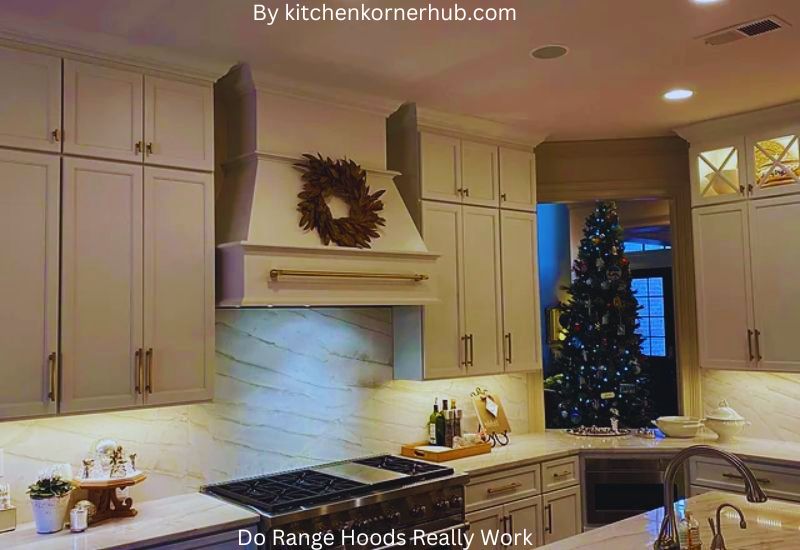
In modern kitchen setups, the range hood has emerged as a crucial appliance that offers numerous advantages beyond its primary function of removing smoke and odors. Let’s delve into the multifaceted benefits that range hoods bring to your kitchen environment.
Improved Air Quality and Comfort:
One of the most evident benefits of using range hoods is their ability to enhance indoor air quality. Cooking activities generate a variety of pollutants, including grease particles, smoke, and lingering odors.
A range hood effectively captures and removes these pollutants from the air, preventing them from spreading throughout your home. This not only maintains a fresh and pleasant atmosphere but also improves the overall comfort and health of your living space.
Enhanced Safety:
Range hoods play a significant role in kitchen safety by preventing the accumulation of harmful substances. Cooking at high temperatures can release gases like carbon monoxide, which, if left unventilated, pose serious health risks.
By swiftly eliminating these gases, range hoods safeguard you and your family from potential hazards. Furthermore, they help prevent the buildup of grease in the kitchen, reducing the risk of fire outbreaks.
Preservation of Kitchen Surfaces and Cabinets:
The accumulation of grease, steam, and other cooking byproducts can have a detrimental impact on your kitchen’s aesthetics and structural integrity. Range hoods help prevent these substances from settling on surfaces,
including cabinets, walls, and countertops. This not only simplifies cleaning but also extends the lifespan of your kitchen fixtures, saving you time and money on maintenance and repairs.
Energy Efficiency:
Modern range hoods are designed with energy efficiency in mind. Equipped with advanced ventilation technologies and adjustable fan speeds, they ensure that you only use the necessary amount of power to effectively clear the air.
This efficiency not only reduces your energy bills but also contributes to a more sustainable lifestyle by minimizing energy wastage.
Cooking Comfort and Precision:
Cooking involves a diverse range of techniques and ingredients, some of which can produce strong odors and vapors. With a range hood in place, you can confidently explore various cooking methods without worrying about lingering smells.
This empowers you to experiment with flavors and cuisines, creating a more enjoyable and rewarding cooking experience. Additionally, range hoods remove excess heat, making the kitchen environment more comfortable and conducive to culinary precision.
Addressing Common Misconceptions About Range Hoods
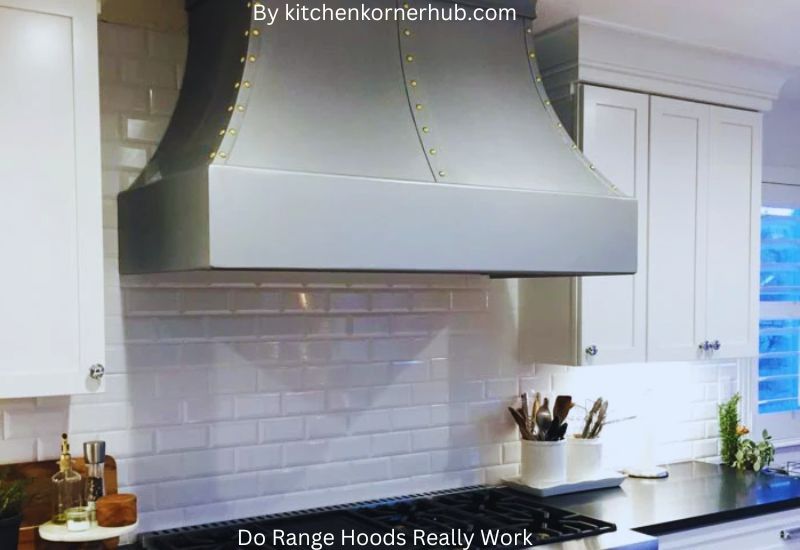
Range hoods play a crucial role in maintaining indoor air quality and promoting a safe cooking environment in kitchens. However, there are several misconceptions surrounding these appliances that need clarification to make informed decisions when choosing and using them.
Range Hoods Are Only Necessary in Commercial Kitchens:
One prevalent misconception is that range hoods are only required in commercial kitchens with heavy-duty cooking equipment. In reality, range hoods are equally important in residential kitchens. They help to remove pollutants, grease, and odors generated during cooking, improving indoor air quality and preventing health issues. Even in smaller households, cooking can release harmful particles and gases that range hoods efficiently capture and expel.
Range Hoods Are Only for Removing Odors:
Another misconception is that range hoods are primarily designed to eliminate cooking odors. While they do contribute to odor reduction, their primary function is to eliminate harmful pollutants and improve air circulation.
Range hoods are equipped with filters that trap grease, smoke, and airborne particles, preventing them from circulating throughout the kitchen and the rest of the home.
All Range Hoods Are Noisy and Inefficient:
Some homeowners avoid installing range hoods due to concerns about noise and energy consumption. However, modern range hoods are designed with advanced technologies that prioritize efficiency and noise reduction.
Many models feature multiple fan speeds, allowing users to adjust ventilation power according to their cooking needs. Additionally, investing in a higher quality range hood often leads to quieter operation and better energy efficiency.
Range Hoods Require Excessive Maintenance:
Some individuals believe that maintaining a range hood is a time-consuming chore. While it’s true that filters and ducts require regular cleaning, newer models often come with user-friendly features that simplify maintenance.
Dishwasher-safe filters and easily accessible components make cleaning a straightforward task. Regular maintenance not only prolongs the lifespan of the range hood but also ensures its optimal performance.
Installing a Range Hood is a Complex and Costly Process:
Many homeowners hesitate to install a range hood due to perceived complexities and costs associated with installation. While it’s true that installing ducted range hoods might require more work, there are also ductless options available that can be simpler to install.
Moreover, the long-term benefits of improved indoor air quality and a safer cooking environment often outweigh the initial installation expenses.
Factors Influencing the Performance of Range Hoods
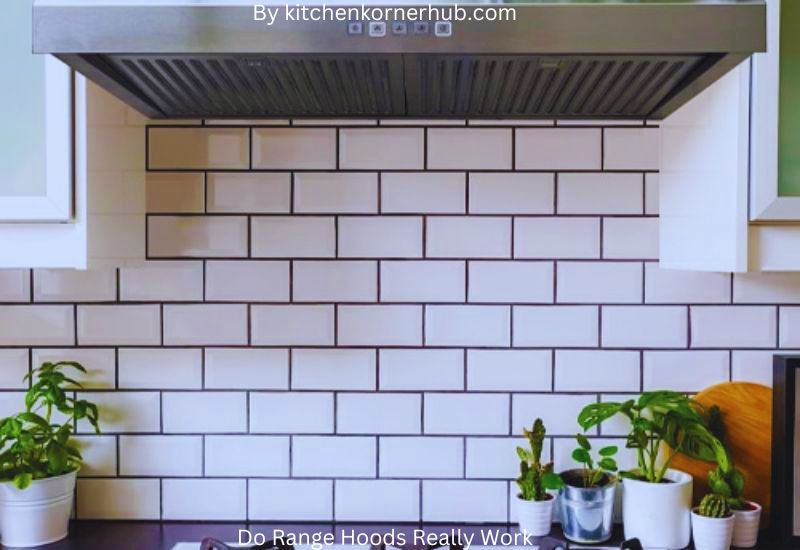
Range hoods play a vital role in maintaining air quality and enhancing the overall cooking experience in kitchens. Their effectiveness depends on a multitude of factors that influence their performance.
Understanding these factors can help homeowners and designers make informed decisions when choosing and utilizing range hoods for optimal efficiency.
Airflow Capacity and Design:
One of the foremost factors influencing range hood performance is its airflow capacity and design. The capacity of the range hood’s fan to effectively pull and exhaust air is critical in capturing and eliminating smoke, odors, and airborne particles.
An insufficient airflow capacity can lead to ineffective ventilation, allowing pollutants to linger in the cooking area. The design of the hood, including the shape and dimensions of the canopy, influence how efficiently it captures and channels the airborne contaminants.
Proper Sizing and Installation:
Sizing and installation play a pivotal role in ensuring a range hood’s performance. A range hood should be appropriately sized according to the cooking appliance’s output and the kitchen’s size.
An oversized or undersized hood can result in either excessive energy consumption or inadequate ventilation. Moreover, proper installation is crucial to maintain the recommended distance between the cooktop and the range hood, ensuring efficient capture of pollutants and safe operation.
Filter Quality and Maintenance:
Filters are fundamental components of range hoods as they trap grease, smoke, and other particles before air is expelled. The quality of filters significantly impacts the unit’s efficiency. Baffle filters and mesh filters are common types used in range hoods.
Baffle filters are efficient in capturing grease, while mesh filters are effective in trapping finer particles. Regular filter maintenance, including cleaning or replacement, is necessary to prevent clogging and maintain optimal airflow and filtration performance.
Ducting and Ventilation System:
The ducting and ventilation system connected to the range hood are critical in directing the captured pollutants outside the kitchen. A well-designed ducting system ensures that the exhausted air doesn’t recirculate back into the kitchen.
The length, size, and configuration of the ducting influence the range hood’s overall performance. Straight, short duct runs with minimal bends and obstructions are preferred to reduce resistance and enhance airflow.
Noise Level and Fan Speed:
Noise level and fan speed are factors that directly affect the user experience of a range hood. While high fan speeds enhance pollutant capture, they can also lead to increased noise levels.
Modern range hoods often feature variable fan speed settings, allowing users to balance performance and noise according to their preferences. Quieter operation can encourage regular use, contributing to better indoor air quality.
Conclusion
In conclusion, the effectiveness of range hoods is undeniable. These essential kitchen appliances play a crucial role in maintaining air quality by effectively removing cooking byproducts such as smoke, grease, and odors. The technology behind modern range hoods has evolved to maximize efficiency, making them highly efficient in reducing indoor air pollution and enhancing overall cooking experience. While individual results may vary based on factors like installation, size, and power, the consensus remains that properly functioning range hoods do indeed work to create a healthier and more pleasant cooking environment in homes.
Frequently Asked Question(Do Range Hoods Really Work)
What are the disadvantages of kitchen hoods?
While kitchen hoods are essential for maintaining a clean and odor-free cooking environment, they do come with a few disadvantages. One notable drawback is the noise they generate. High-powered range hoods can be quite loud, potentially disrupting conversations or causing discomfort.
Additionally, the installation process can be complicated and may require professional help, adding to the overall cost. Another consideration is the maintenance required for kitchen hoods. Filters need regular cleaning or replacement to ensure efficient functioning, and grease buildup in the ducts can pose a fire hazard. Lastly, in some cases, the size and design of the kitchen hood might not align well with the overall aesthetic of the kitchen.
Do ductless range hoods actually work?
Ductless range hoods do work to some extent, but their effectiveness depends on the specific cooking habits and needs of the user. These hoods use filters to trap grease and odors before recirculating the air back into the kitchen.
While they can improve indoor air quality to a certain degree, they might not be as efficient as vented hoods in removing heat and steam. Ductless range hoods are better suited for kitchens where installing ductwork for ventilation is challenging or not feasible. However, it’s important to note that ductless range hoods still require regular filter maintenance to maintain their effectiveness.
Do range hoods have to be vented outside?
Range hoods don’t necessarily have to be vented outside, but venting them outdoors offers several benefits. Vented range hoods, also known as ducted range hoods, expel smoke, odors, heat, and airborne particles directly outside, resulting in better indoor air quality.
This is particularly important when cooking strong-smelling or greasy dishes. However, ducting requires proper installation and might not be possible in all kitchen layouts. In such cases, ductless range hoods can be used as an alternative, but they might not provide the same level of ventilation efficiency.
What are the benefits of a range hood?
Range hoods offer several benefits that contribute to a healthier and more pleasant cooking environment. One of the key advantages is their ability to remove smoke, steam, grease, and odors generated during cooking. This helps maintain indoor air quality and prevents the spread of cooking-related pollutants throughout the house.
Additionally, range hoods can help control excess heat, making the kitchen more comfortable for cooking. By preventing the accumulation of grease and grime on surfaces, they also contribute to easier cleaning and maintenance. Lastly, range hoods can enhance the overall aesthetic of the kitchen, serving as a focal point or complementing the design style with various available options.
What are the pros and cons of kitchen hoods?
Kitchen hoods, also known as range hoods, have both advantages and disadvantages. On the positive side, they play a crucial role in maintaining good indoor air quality by removing smoke, steam, and cooking odors. This helps keep your kitchen fresh and free of lingering smells. Additionally, kitchen hoods can prevent grease and grime buildup on your kitchen surfaces and cabinets, making it easier to clean and maintain a hygienic environment.
Moreover, they enhance safety by removing harmful fumes and reducing the risk of fire hazards during cooking. On the downside, kitchen hoods can be expensive to purchase and install, and they may require regular maintenance to function efficiently. Some people find them noisy, which can be a drawback in open-concept kitchen and living spaces. Furthermore, if not properly vented, they might only recirculate the air instead of expelling it outside, which can be less effective in eliminating cooking pollutants.
Do range hoods use a lot of electricity?
As for electricity usage, the amount of electricity a range hood consumes can vary depending on its type and usage. Traditional ducted range hoods, which vent air outside, typically use more electricity because they have to power a fan to expel air through the ducts. On the other hand, ductless or recirculating range hoods use less electricity as they filter and recirculate the air back into the kitchen. However, they might still require power for fans and lighting.
The energy consumption of a range hood also depends on the fan speed and how often it is used. Using the hood at lower settings when cooking with less smoke and steam can help reduce electricity usage. In summary, while range hoods do consume electricity, the extent of their energy usage depends on various factors, and there are options available that can be more energy-efficient.

